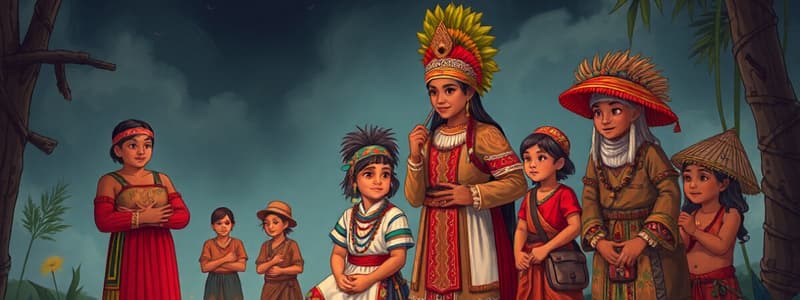Podcast
Questions and Answers
How many ethnic groups are estimated to exist in the Philippines?
How many ethnic groups are estimated to exist in the Philippines?
At least 106 ethnic groups.
Which of the following is NOT a basis for ethnic identity in the Philippines?
Which of the following is NOT a basis for ethnic identity in the Philippines?
- Religion
- Wealth (correct)
- Domicile
- Language
There are 172 languages spoken in the Philippines, including foreign languages.
There are 172 languages spoken in the Philippines, including foreign languages.
True (A)
What percentage of the Philippine population is Roman Catholic according to the 2010 Census?
What percentage of the Philippine population is Roman Catholic according to the 2010 Census?
What do the Tagalog people identify as?
What do the Tagalog people identify as?
Match the ethnic groups to their environmental setting:
Match the ethnic groups to their environmental setting:
Which group is considered the first inhabitants of the Philippines?
Which group is considered the first inhabitants of the Philippines?
How many ethnic groups does the National Commission on Indigenous Peoples (NCIP) identify in the Philippines?
How many ethnic groups does the National Commission on Indigenous Peoples (NCIP) identify in the Philippines?
What primary criterion is used to categorize ethnic groups in the Philippines?
What primary criterion is used to categorize ethnic groups in the Philippines?
What percentage of the Philippine population is Roman Catholic according to the 2010 Census?
What percentage of the Philippine population is Roman Catholic according to the 2010 Census?
What is the total number of languages spoken in the Philippines?
What is the total number of languages spoken in the Philippines?
What cultural items are found among various Philippine ethnic groups?
What cultural items are found among various Philippine ethnic groups?
The ____ were the first inhabitants of the Philippines.
The ____ were the first inhabitants of the Philippines.
Match the following ethnic groups with their corresponding environmental setting:
Match the following ethnic groups with their corresponding environmental setting:
Flashcards
Indigenous Groups
Indigenous Groups
A term used to describe individuals and communities who maintain their traditional beliefs and practices, differing from the mainstream Philippine society. They are often geographically isolated and have specific cultural traits.
NCIP
NCIP
The National Commission on Indigenous Peoples, responsible for recognizing and protecting the rights and cultures of indigenous groups in the Philippines.
Philippine Languages
Philippine Languages
The diverse languages spoken in the Philippines, including 169 indigenous languages (168 spoken, 1 sign) and 172 in total.
Domicile
Domicile
Signup and view all the flashcards
Phenotypic Characteristics
Phenotypic Characteristics
Signup and view all the flashcards
Religion
Religion
Signup and view all the flashcards
Culture Traits
Culture Traits
Signup and view all the flashcards
Ancestry/Migration History
Ancestry/Migration History
Signup and view all the flashcards
Tagalog
Tagalog
Signup and view all the flashcards
Cebuano
Cebuano
Signup and view all the flashcards
Ilocano
Ilocano
Signup and view all the flashcards
Gongs
Gongs
Signup and view all the flashcards
Bost Gong
Bost Gong
Signup and view all the flashcards
Jawbone Gong Handle
Jawbone Gong Handle
Signup and view all the flashcards
Study Notes
Ethnic Groups in the Philippines
- There is no definitive count of ethnic groups in the Philippines, as some have formed and vanished over time.
- The National Commission on Indigenous Peoples (NCIP) recognizes 110 indigenous groups in the Philippines.
- Indigenous groups are those who have relatively maintained their traditional beliefs and practices and are distinct from the mainstream Philippine society.
- Ethnic identity is based on various factors, including:
- Language: The Philippines has 172 languages with 169 indigenous languages (168 spoken, 1 visual: Filipino Sign Language)
- Domicile: Mountain, coastal, or forest peoples
- Phenotypic Characteristics: Primarily Negrito (aboriginal) and Austronesians.
- Religion: 81% Roman Catholic, 6% Muslim, 3% Evangelicals, 2% Iglesia ni Cristo, 8% others.
- Culture Traits: Costumes, body decoration, musical instruments, weapons, ritual practices.
- Ancestry/Migration History: Negritos were the first inhabitants (c. 30,000 years BP) and Austronesians arrived later (c. 2500 BC).
Environmental Setting of Ethnic Groups
- The names of many ethnic groups relate to their location:
- Water-Based:
- Tagalog (river people)
- Kapampangan (coast people)
- Tausug (current people)
- Iraya Mangyan (upstream people)
- Meranao (lake people)
- Sama Dilaut (sea people)
- Mountain:
- Bukidnon (mountain people)
- Igorot (ridge people)
- Remontado (mountain retreaters)
- Tinguian (highland people)
- Bontok (mountain)
- Tao't Bato (stone cave people)
- Forest:
- Ikalahan (forest people)
- Gubatnon (forest people)
- Water-Based:
Major Ethnic Groups
- The 2000 Census of Population and Housing identified major ethnic groups:
- Tagalog (28.16%) - Metro Manila area
- Cebuano (23.12%) - Central Philippines
- Ilocano (9.07%) - Northwestern Luzon Islands
- Hiligaynon (7.57%) - Visayas central Philippines
- Bikol (6.01%) - southern Luzon
- Waray (3.36%) - Eastern Visayas
- Kapampangan…
Gong Culture
- Gongs are musical instruments found throughout the Philippines:
- Flat brass gongs are found in Luzon (northern Philippines).
- Bost gongs are found in Visayas and Mindanao (central Philippines).
- Some gongs use a human jawbone as a handle, referencing head-taking practices in Northern Luzon.
Studying That Suits You
Use AI to generate personalized quizzes and flashcards to suit your learning preferences.



